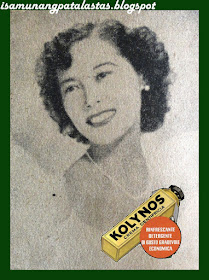 |
| "O, ANONG SARAP...ISA PA NGA", one of San Miguel Beer's widely popular ad campaign with a tagline written by Hotdog member, Dennis Garcia. ca. 1971 |
For decades now, San Miguel Corporation, led by its flagship
product San Miguel Beer has consistently put out advertisements that make the
Filipino proud. The signature beer product—SAN MIGUEL BEER PALE PILSEN—has
celebrated the Filipino in his most positive facets.
The San Miguel Beer ad campaigns, in varying degrees, have
toasted the Filipino at his best—his irrepressible sense of humor, his regard
for tradition, his infectious optimism,
and most of all, his taste for the good
life. These values find full expression in the campaign , “O, Anong
Sarap! So good…ayos na ang kasunod!,” that was launched in 1971.
“O Anong Sarap!”, was the first Tagalog commercial ever for
the country’s no. 1 beer. The landmark ad, produced by Philippine Advertising
Counselors (PAC) ran for many years, and featured local showbiz stars—from
Bert “Tawa” Marcelo to Dencio Padilla, Gary Lising, Cachupoy and Subas
Herrero—a tradition by the brand started way back in the 1960s.
WATCH SAN MIGUEL BEER TVC HERE,
"BOSS", with Bert Marcelo & Subas Herrero
One major contributor to this campaign was a young 18
year-old copywriter who penned the tagline, and went on to create many more San
Miguel Beer ads, jingles and slogans. Dennis Garcia—who would also gain fame by
being a part of the iconic purveyor of original Pilipino music, the Hotdog
Band---came up with “O, Anong Sarap—so good, ayos na ang kasunod!”. He later re-wrote the second part into “Isa pa nga!”, which
became even a more popular catchphrase, it replaced “so good…” permanently.
The agency was recognized for its pioneering use of Filipino
talents, themes and values in its commercial in 1979 when PAC received the
prestigious Tanglaw Awards from the 4 A’s (Association of the Advertising
Agencies of the Philippines”.
After the dreadful Martial law years, San Miguel Beer continued
to portray the vibrant and hopeful Pinoy spirit in its campaign “Ito ang
Beer!”. Dennis worked on the San Miguel account again in 1990 when he was lured
out of his expat job in Malaysia by McCann Erickson, to help keep the client in
a multi-agency pitch. The chemistry resulted in the successful “Kahit Kailan,
Kaibigan” campaign and helped McCann keep the multi-million-peso account .
“A big idea is big only once,” Dennis, once said. And that
was what happened in 1971, when people lapped up his very first campaign for
San Miguel Beer in 1971, and never had enough of it—“O, Anong Sarap! Isa Pa
Nga!”





















